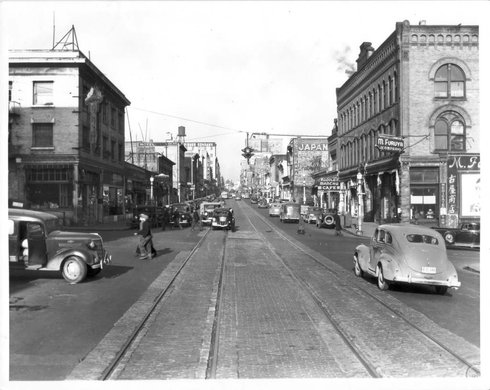

Photo by Morf Morford
By Morf Morford
Tacoma Daily Index
My heart always drops when I hear Tacoma mentioned in the national (or, even worse, international) news.
Every other city, it seems, is mentioned in a variety of contexts; political conventions, sporting events, corporate or celebrity gatherings – but not Tacoma.
Whether it’s Ted Bundy, David Brame, the DC sniper, cop-killings at Forza, or murder with particularly gruesome details or the memorable collapse of the Narrows Bridge, you can count on a Tacoma connection.
Maybe the “T” in “T-Town” stands for trouble.
Like many individuals, cities sometimes acquire nick-names that they have earned or may aspire to; New York is the Big Apple, Seattle is the Emerald City, Tacoma is T-Town.
You have to love the alliteration of T-Town. You can feel the nice solid tone of the consonants – think of a few other strong double “T” words or terms; “terrible-twos,” tomato, toothpaste, toilet.
They all have a strong rhythmic connection to T-Town.
Not every city has a name that invites rhyming. Can you think of a word that rhymes with San Diego? Or Phoenix? Or Bellevue?
Once again, Tacoma lucks out. We have the ever memorable, mnemonic flowing term: “Tacoma-aroma” forever associated with our fair city.
The dictionary meaning of the word “aroma,” at least before it was linked with Tacoma, primarily meant “a pleasing scent.” But we’ve taken care of that.
The stench of the pulp mills might be long gone, but the name and associations of Tacoma as a toxic industrial wasteland will linger forever.
And for good reason; for decades that distinctly bitter odor was our welcome mat, our first impression to real (or potential) visitors. You knew you were in Tacoma when that smell hit you.
And if you had any choice in the matter, you kept on going.
Without the pulp mills, may I suggest a game that you play with out-of-town visitors; “You know you’re in Tacoma when…”
For example, “You know you’re in Seattle when…the traffic stops.”
What is that sense, that smell, view or feeling when you just know you are in Tacoma?
Gertrude Stein had a great line to sum up San Francisco’s great shadow city, Oakland; “There’s no there, there.”
Tacoma’s ahem, destiny, seems to forever be, like San Francisco’s Oakland, Seattle’s working-class brother or ugly step-sister, its “shadow city.”
But is there really no “here, here”?
Tacoma’s literal city boundaries are vague enough, but our cultural identity is even more ambiguous. In both senses, we sprawl with little definition.
Some historic cities, like London, Paris or Rome have layers of history under their contemporary streets and surfaces. For the most part, Tacoma’s identity is what we see.
Seattle has the Space Needle, The Seattle Center and defining industries and businesses; Starbucks, Amazon, Boeing, Microsoft and many more.
Tacoma has…. hmmmm. Tacoma’s largest employer is JBLM. The second largest employer is local school districts. The third largest set of employers are local medical providers. The vast majority of employment in Pierce County is with the military, local schools or healthcare.
Where are the independent, entrepreneurial, privately-owned businesses that Seattle is famous for?
One irony is that about 100,000 Pierce County residents work outside of Pierce County. How many people do you know who work in or near Seattle but can’t afford to live there?
We have a flourishing real estate market in Pierce County – but have you noticed how many of the home purchases are by people from King County?
Virtually every city on the West Coast has a thriving China town – San Francisco, Portland, Seattle and even Vancouver and Victoria – but not Tacoma. We did have a flourishing Chinese community early in our history – until 1885.
We also had a thriving Japanese community (up hill from the UWT campus) until the relocations and internment camps of 1942.
Like most cities, we have those historically defining tipping-points we’d rather not remember. Tacoma has several huge events that linger over us like unforgettable bad dreams; one is the so-called “Tacoma method” – still resonating across Asia. This is the first impression we have given to most Asians –long before they ever come here. And even now, many Chinese students prefer to study anywhere except Tacoma. Our violent and brutal expulsion of the Chinese in 1885 is still in their history books – if not in ours.
For more information on this chapter of Tacoma history, look here – http://www.tacomachinesepark.org/ or here – http://www.bbc.com/news/av/magazine-31654231/tacoma-s-chinese-community-faces-painful-past.


Our destruction of Tacoma’s Japan town closed a rich chapter of our cultural tapestry. (For details, look here – https://tacomahistory.live/2017/01/30/days-of-departure/)
The lynching of Chief Leschi of the Nisqually tribe in 1858 (at what is now a strip mall in Lakewood) encapsulated our sense of mob justice in the eyes of the native people – and perhaps our own. We showed them, and ourselves, who, under pressure and in the grip of fear, we really are.
And now, thanks to the national, if not international, media, the whole world knows, if it didn’t know before, that the “T” in “T-Town” stands for trouble.
Maybe that’s how you know you’re in Tacoma: we aren’t really a place – we are an attitude.








